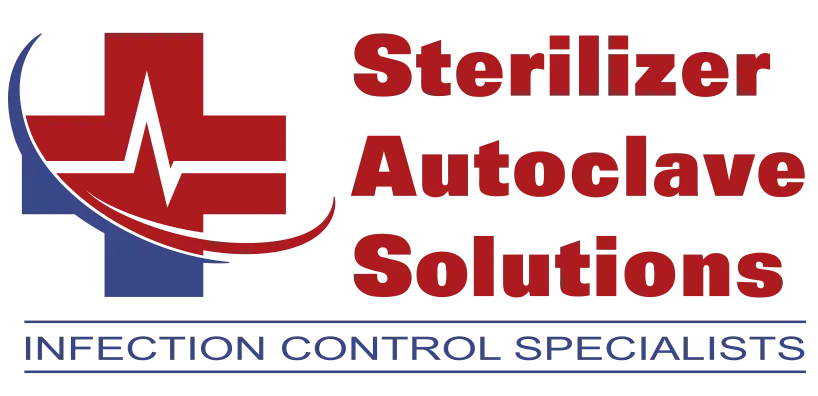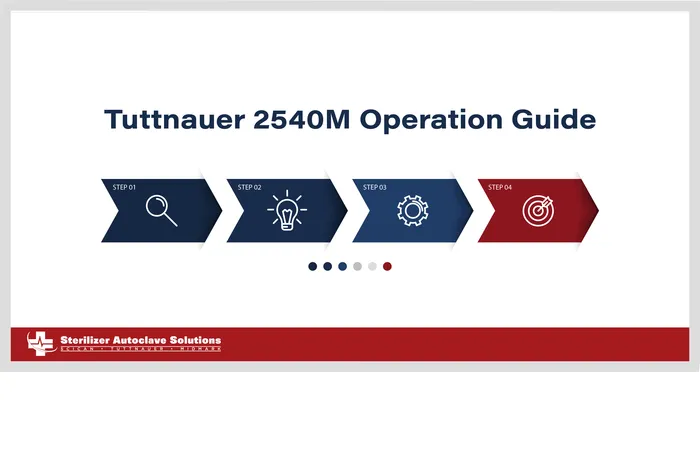Tuttnauer 2540M Operation Guide
Recently, we wrote about the Tuttnauer 2540M, and created an installation guide for it as well. So this article will be dedicated to the next step, the operation guide for the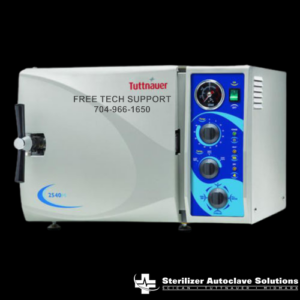 Tuttnauer 2540M. As always, the purpose of this article is to guide you through the operation of the 2540M, using the guide provided directly by Tuttnauer. It is important to follow these instructions carefully in order to ensure that any and all operation is carried out to the manufacturer’s specifications. If you would like to access a digital version of the 2540M manual, you can use this link to our resources tab where our manuals are located.
Tuttnauer 2540M. As always, the purpose of this article is to guide you through the operation of the 2540M, using the guide provided directly by Tuttnauer. It is important to follow these instructions carefully in order to ensure that any and all operation is carried out to the manufacturer’s specifications. If you would like to access a digital version of the 2540M manual, you can use this link to our resources tab where our manuals are located.
Operation Guide
Preparation Before Sterilization
The purpose of packaging and wrapping items for sterilization is to provide an effective barrier against contamination during storage, once the items have been sterilized.
VERY IMPORTANT!
When sterilizing cotton wool or pads, it is essential to wrap them in paper or cotton bags in order to prevent the multi-purpose valve and the autoclave openings from becoming clogged with remnants of the material.
Packaging and wrapping materials should be approved for use in a steam sterilizer and permit the removal of air and penetration of the steam during the sterilization process.
The basic principle of determining the size, mass and contents of instrument and hollowware packs is that the contents are sterile and dry immediately upon completion of the drying cycle.
Instruments to be sterilized must be clean and free from any residual matter, such as debris, blood, pads or any other material. Such substances may cause damage to the instruments themselves or the sterilizer.
Clean instruments immediately after use. It is recommended that instruments be ultrasonically cleaned in a Tuttnauer Clean and Simple Ultrasonic Cleaner, using Tuttnauer Clean and Simple enzymatic cleaning solution.
After ultrasonic cleaning, rinse under tap water for 30 seconds and pat dry to remove residual minerals. If your tap water has a high mineral content, rinse a second time in a bath of distilled water and pat dry.
Launder textile wraps prior to reuse, but do not use bleach.
Follow the instrument manufacturer’s instructions for cleaning and lubricating instruments.
Be sure that instruments of dissimilar metal (stainless steel, carbon steel, etc.) are separated. Carbon steel instruments should be bagged or placed on autoclavable towels and not directly on stainless steel trays. (Mixing will result in the oxidation of these metals).
Load items within the boundaries of the tray so that they do not touch the chamber walls, or fall off when the tray is inserted into the autoclave. The chamber walls are very hot; items that come into contact with the wall can be damaged
Check the manufacture’s instructions as to the proper procedure for sterilizing each item. The instrument manufacturer can give specific information on proper sterilization temperature and sterilization time for any item.
Place a sterilization indicator in each tray or inside each wrapped pack.
When using a paper / plastic bag, the plastic side should always be down. Use single-use wraps once only and discard after use.
Verify that the packaging method is in accordance with good practice approach and the packaging materials are in accordance with the applicable standards (e.g. EN868 series).
At least once per week use a biological spore test (Bacillus Stearothermophilus) in any load to insure proper sterilization. (Be aware testing standards may vary).
All instruments must be sterilized in an open position. Place instruments with ratchets opened and unlocked or clipped on the first ratchet position. Surfaces that are hidden because the item is in a closed position will not be exposed to the steam and will not be sterilized.
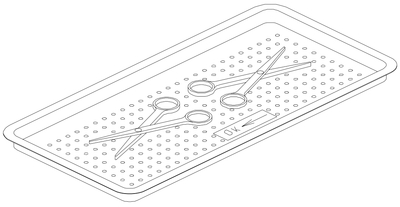
Disassemble or sufficiently loosen multiple-part instruments prior to packaging to permit the sterilizing agent to come into contact with all parts of the instrument.
Make sure that all instruments remain apart during the sterilization process. Surfaces that are hidden because items are covering other items will not be exposed to the steam and will not be sterilized.
Items prone to trapping air or moisture, e.g. hollowware, should be tilted on edge. This will allow a minimal resistance to the removal of air or condensate during sterilization and drying.
The operator may use racks to allow for adequate separation of packaged instruments.
Do not overload the sterilizer trays. Overloading will cause inadequate sterilization and poor drying. Load trays loosely to capacity. Instruments should be loaded one level deep only.
Tubing should be rinsed after cleaning. When placed in the tray, make sure that both ends of the tubing are open and there are no sharp bends or twists.
Empty canisters should be placed upside-down, in order to prevent accumulation of water.
Allow a distance of approximately 1” (2.5 cm) between trays or cassettes to permit steam circulation.
Wrapped instruments should be packed in material which will allow steam penetration and promote drying, such as autoclave bag, autoclave paper, or muslin towels.
22.) Do not stack pouches. It is recommended that a Tuttnauer Pouch Rack (below) be used. This will allow the operator to place pouches on their side, which will increase capacity and will allow for better exposure to steam for sterilization and better circulation of air for drying.
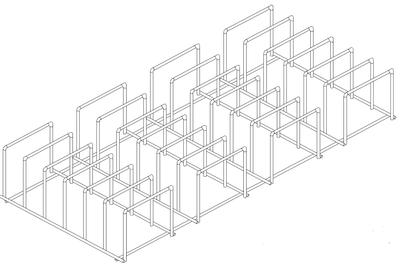 If spotting is detected on the instruments, the first step would be to use an ordinary eraser to remove the spot. If there is no pitting under the spot, the spot was only dirt. Dirt spots on an instrument may be an indication that the autoclave needs to be cleaned or that the instruments were not adequately cleaned or dried. If removal of the spot reveals pitting, the spot was most likely rust. Rust spots on an instrument are not uncommon on inexpensive instruments. It may also be an indication that the instruments were rinsed in tap water with a high content of minerals. These minerals when exposed to high temperature and steam will accelerate the oxidation of the metal. One suggestion would be to final rinse the instruments in distilled water.
If spotting is detected on the instruments, the first step would be to use an ordinary eraser to remove the spot. If there is no pitting under the spot, the spot was only dirt. Dirt spots on an instrument may be an indication that the autoclave needs to be cleaned or that the instruments were not adequately cleaned or dried. If removal of the spot reveals pitting, the spot was most likely rust. Rust spots on an instrument are not uncommon on inexpensive instruments. It may also be an indication that the instruments were rinsed in tap water with a high content of minerals. These minerals when exposed to high temperature and steam will accelerate the oxidation of the metal. One suggestion would be to final rinse the instruments in distilled water.
If the instruments exhibit a discoloration, this can be due to the mixing of carbon steel and stainless steel. When these two metals come into contact with each other electrolysis occurs that breaks down the metal. The best solution is to separately wrap the carbon steel to insulate it from other instruments or the trays.
Packs
VERY IMPORTANT!
When sterilizing cotton wool or pads, it is essential to wrap them in paper or cotton bags in order to prevent the multi-purpose valve and the autoclave openings from becoming clogged with remnants of the material.
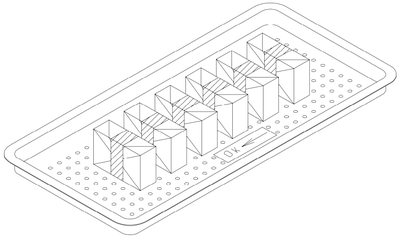 Place packs upright on trays, side by side.
Place packs upright on trays, side by side.- Packs should not touch the chamber walls.
- Pack instrument sets in a manner that prevents damage to delicate items.
- Pack hollowware sets so that all openings face the same direction and so that the contents cannot move inside the pack.
- Load packs of folded operating room drapes with layers vertical, allowing air to be removed from the packs rapidly.
- Do not place packs of hollowware and trays of instruments above textile packs or soft goods in order to avoid wetting caused by condensation from items above.
- Load items packed in flexible packaging materials on edge with paper to laminate, or flat with the plastic surface downwards.
Note: The instrument manufacturer’s recommendations shall be observed, concerning the sterilization data for each type of material.
Tubing
When placing in a tray, make sure that both ends are open, without sharp bends or twists.
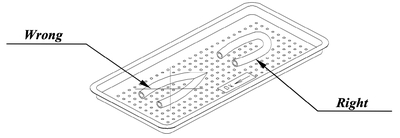 Cassettes
Cassettes
Instruments may be sterilized in cassettes. The advantage of the cassettes is that the sterilized instruments may remain organized in the cassettes ready for use, while stored in a sterile area.
If using models 2340 / 2540, remove the trays and slide the cassettes into the chamber on the rack system.
If using models 3850 / 3870, place the cassettes directly on the tray, either lying flat (but no stacking) or on edge.
Operation
To avoid possible damage, do not leave the autoclave unattended while in operation.
Make sure the power cord is plugged into the back of the unit and also plugged into a power source.
Loading and Unloading the Device
Safety
Protective equipment, clothes and other safety instructions should be implemented in accordance with local and national regulations and/or rules!
For proper sterilization – Do not overload the chamber. Only autoclavable products shall be used; please refer to the material or instrument manufacturer’s instructions for sterilization of unknown materials or instruments.
Loading
Correct loading of the autoclave is essential to successful sterilizing for several reasons. Efficient air removal from the chamber and the load will permit steam penetration and saturation, and allow proper drainage of condensate. Additionally, correct loading will reduce damage to packs and their contents and maximize efficient use of the sterilizer.
For detailed loading instructions, see sec. 6 (Preparation before sterilization).
Unloading
On completion of the cycle, the load shall be immediately removed from the sterilizer and a visual inspection made to ascertain that the load is dry, and that sterilizing indicators have made the required color change.
Fill the Water Reservoir
Ensure that the drain valve is in a CLOSED position.
Remove the water reservoir cover.
Pour distilled water into the reservoir through the opening
on top of the autoclave, until it reaches the base of the safety valve holder. Under no circumstances fill any higher than the base of the safety valve holder.
For proper operation make sure the water level is above the coils of the cooling coil.
Caution: Under no circumstance should water be filled above the safety valve holder.
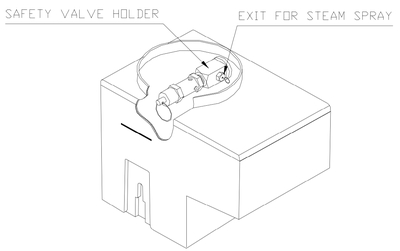 USE DISTILLED WATER ONLY. Use water-having characteristics as per table in sec 5. The impurities in tap water will create the need for more frequent cleaning and maintenance, in addition, they will accumulate and block the hole of the Air Jet. This will prevent the temperature in the chamber from rising properly. This will cause spore tests to fail and indicator strips will not change color. It is essential from time to time, during heating and sterilization phases, that a spray of steam should escape, from the Air Jet, causing a hissing sound. If no escaping steam is evident or no hissing sound heard, follow the instructions in sec 8.3 for cleaning the Air Jet.
USE DISTILLED WATER ONLY. Use water-having characteristics as per table in sec 5. The impurities in tap water will create the need for more frequent cleaning and maintenance, in addition, they will accumulate and block the hole of the Air Jet. This will prevent the temperature in the chamber from rising properly. This will cause spore tests to fail and indicator strips will not change color. It is essential from time to time, during heating and sterilization phases, that a spray of steam should escape, from the Air Jet, causing a hissing sound. If no escaping steam is evident or no hissing sound heard, follow the instructions in sec 8.3 for cleaning the Air Jet.
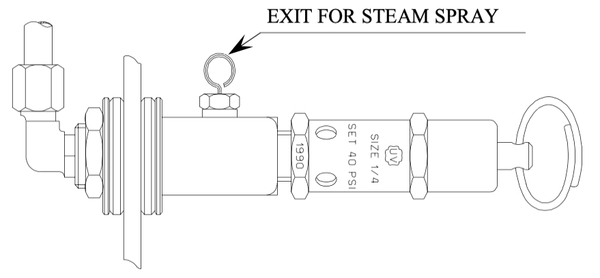 Caution: Daily before operation, check the water level in the reservoir and add water when required. Once a week or after 20 cycles (the shorter period) replace the water in the reservoir.
Caution: Daily before operation, check the water level in the reservoir and add water when required. Once a week or after 20 cycles (the shorter period) replace the water in the reservoir.
- Move the ON / OFF rocker switch, located on the front panel, to the ON position. The green Power Light will turn on, indicating that power is ready to be supplied to the Heating Elements.
- Turn the red tracking needle on the pressure gauge counterclockwise to 0 psi. The tracking needle will indicate the highest pressure reached during the cycle.
- Open the front door of the autoclave and set the Multi-purpose valve knob to the FILL WATER position.
- The water will now flow into the chamber.
- The water should cover the bottom of the chamber up to the groove in the front. This amount of water should be in accordance with the table in sec 4.2.
- When the water reaches the mark at the front of the autoclave, set the multi-purpose valve knob to the STERILIZE position.
Note: When used for the first time, the multi-purpose valve requires slight effort, but with use it will turn smoothly and easily.
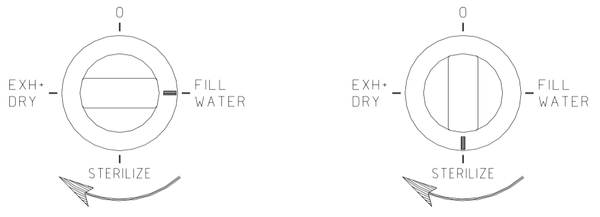 Warning! The Multi-purpose valve knob should be turned in a clockwise direction only!
Warning! The Multi-purpose valve knob should be turned in a clockwise direction only!
- Load the autoclave. See section “Preparation for Sterilization” for information on proper loading.
- Shut the door, move the Door Closing Devise into position and tighten, making sure that the Door Switch is activated.
NOTE:
Due to the inherent elasticity of the door gasket, it is important to tighten the door bolt until “hand tight”. Do not over-tighten the bolt as this may result in damage to the gasket.
Should the autoclave fail to reach the sterilizing temperature/pressure, always check first that the door is fully sealed. If not, tighten the door bolt further, as described above, until completely sealed.
- Turn the thermostat knob to the desired sterilization temperature.
Note: This autoclave is designed according to all international standards, which allows the temperature to raise 4oF (2oC) over the working temperature.
Sterilization Time Table
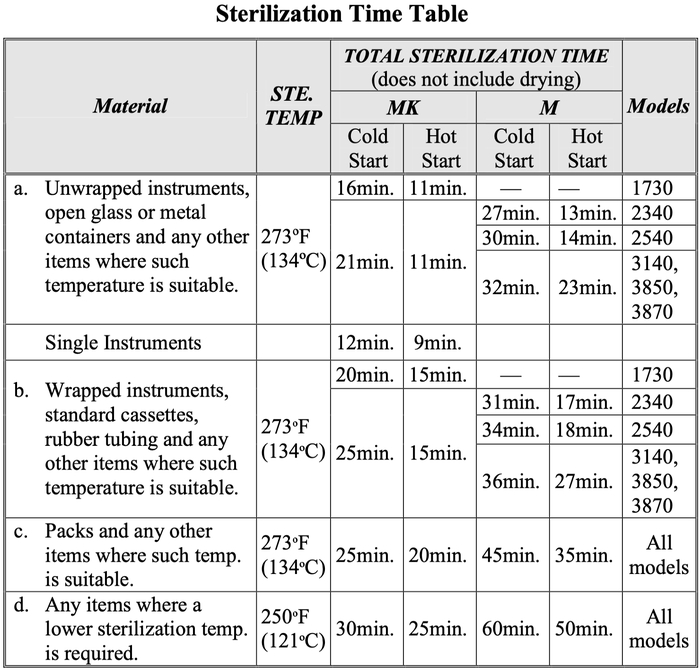
Note: The table shows different times for M (Standard Manual) & MK (Kwiklave Manual) units as well as for hot and cold starts. Make sure you are using the correct times for your model machine. A hot start is any cycle that is begun within 1 hour of a previous cycle ending (including drying time).
Note: These sterilization times are based on the unit being supplied the correct voltage, as indicated on the Technical Label attached to the outer cabinet. If the voltage supplied is substantially less than the indicated voltage, additional time must be added to each cycle.
Set the Timer to the desired sterilization cycle time according to the Sterilization Time Table.
- The Heat Light will come on, indicating that power is being supplied to the Heating Elements and remain on until the correct sterilization pressure is achieved.
- Once the correct pressure is reached the Heat Light will cycle on and off, indicating that the Heating Elements are turning on and off to maintain the correct sterilization pressure.
- When the Timer reaches 0 min, the Heating Elements are turned off and a buzzer will sound indicating that the sterilization cycle is complete.
If unwrapped instruments were sterilized and no drying is required, follow these steps.
- Once the Timer has reached 0 min, turn the Multi-purpose valve knob promptly to the Exhaust / Dry position. This will allow the steam and leftover water to return to the reservoir.
- When the white needle on the pressure gauge has reached 0 psi, the door can be opened.
- Unscrew the Door Closing Device, move it to the side and open the door to remove the instruments.
- Now turn the Multi-purpose valve knob to the “0” or off position.
Note: The sterility of instruments processed in unwrapped cycles cannot be maintained if exposed to a non-sterile environment.
If wrapped instruments were sterilized and drying is required, follow these steps.
- Once the Timer has reached 0 min, turn the Multi-purpose valve knob promptly to the Exhaust / Dry position. This will allow the steam and leftover water to return to the reservoir. Do not allow the pressure to drop below 10 psi before beginning this procedure. This will cause water to remain in the bottom of the chamber even after the Multi-purpose valve has been turned to Exh / Dry. Resetting the Timer for drying will only be heating up this water and not drying the instruments.
If the pressure has dropped below 10 psi, leave the unit in the STERILIZE position, leave the door closed and locked. Now reset the Timer for 10 minutes.
When the Timer reaches 0 min, the pressure should be above 10 psi (if not, add 5 more minutes to the Timer). Now turn the Muli-purpose valve to the Exh / Dry position. This will insure that all the water has been returned to the reservoir.
Note: The sooner the Multi-purpose valve is turned to Exh / Dry at the end of the sterilization cycle, the more effective and efficient will be the drying.
When the white needle on the pressure gauge has reached 0 psi the door can be opened.
Unscrew the Door Closing Devise as far as it will go, but do not move it to the side, this will allow the door to open about 3⁄4 of an inch.
Leave the Multi-purpose valve knob in the Exhaust / Dry position.
Reset the Timer for drying, 20 – 30 minutes, the Dry Light will come on indicating that Drying is active and the Heating Elements are back on.
When the Timer reaches 0 min., the drying is complete and the Dry Light and Heating Elements will turn off.
Unscrew the Door Closing Device, move it to the side and open the door to remove the instruments.
Now turn the Multi-purpose valve knob to the “0” or off position.
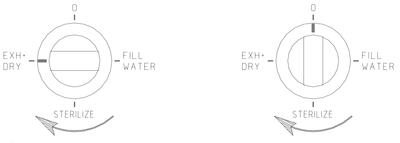 Warning! Multi-purpose valve knob should be turned in a clockwise direction only.
Warning! Multi-purpose valve knob should be turned in a clockwise direction only.
At the end of the day, turn the ON / OFF rocker switch to the OFF position.
As always if you have any questions about this process or anything else please feel free to contact us and take advantage of our “FREE TECH SUPPORT.”
We also offer FREE VIRTUAL TECH SUPPORT to “See and Talk” with a “Real Time Live Technician” for any problems you may be in need of help with.
You can also use our “FREE MAINTENANCE PROGRAM”. Take the guesswork and worrying about what unit is due for maintenance and which maintenance cycle it is time for. We will keep track of all your autoclaves and let you know when it’s time for anything.
